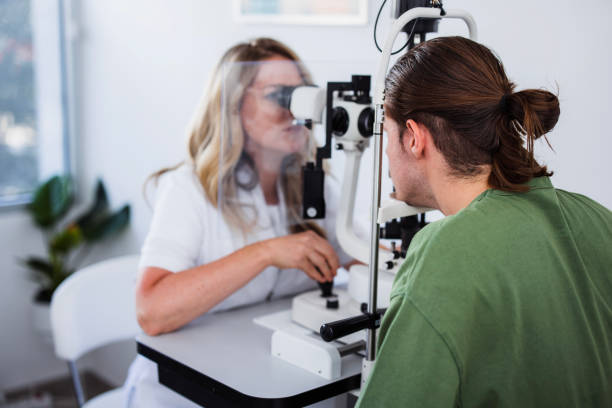Myopia, commonly known as nearsightedness, is a vision condition where distant objects appear blurry while close objects are seen clearly. In recent years, myopia has become a growing concern in Singapore, especially among children and young adults. With one of the highest myopia control rates in the world, the need for awareness and effective control measures has become essential. Understanding what causes myopia and how to manage it can help reduce risks of severe eye complications later in life.
Causes of Myopia Development
Several factors contribute to the rise of myopia, particularly in urban environments like Singapore.
Genetic Factors
Children with one or both parents who are myopic have a higher chance of developing the condition. Genetic predisposition plays a significant role in determining eye growth patterns.
Environmental Influences
Lifestyle choices strongly affect eye health. Prolonged screen time, frequent use of digital devices, and reduced time outdoors are linked to the increasing prevalence of myopia in Singapore.
Visual Demands in Education
Singapore’s competitive academic environment often requires long hours of near work such as reading, writing, and computer use. This continuous strain on the eyes increases the risk of developing myopia in school-aged children.
Importance of Myopia Control
Myopia control is not just about correcting blurred vision with glasses. It involves slowing down the progression of nearsightedness to prevent severe eye health issues.
Long-Term Eye Health Risks
High myopia increases the risk of retinal detachment, glaucoma, and macular degeneration. These conditions can lead to permanent vision loss if not addressed early.
Quality of Life
Uncontrolled myopia affects daily activities, school performance, and even career opportunities. Controlling myopia early helps maintain clearer vision and better eye health throughout life.
Public Health Impact
With a high percentage of young people affected, myopia is not only a personal health issue but also a public health concern in Singapore. Early intervention reduces future healthcare costs and the burden of vision-related complications.
Methods of Myopia Control
There are several clinically proven approaches to slow down the progression of myopia.
Lifestyle Modifications
Increasing outdoor time has been shown to reduce the risk of myopia in children. Exposure to natural light helps regulate eye growth and reduces strain. Parents are encouraged to limit screen time and encourage breaks from near work.
Optical Interventions
Specialized lenses can be used to manage myopia progression.
- Multifocal glasses provide different zones for near and distance vision, reducing eye strain.
- Orthokeratology (Ortho-K) lenses are worn overnight to temporarily reshape the cornea, offering clear vision during the day without glasses.
Multifocal contact lenses are designed to slow down myopia progression while providing clear vision.
Pharmacological Treatment
Low-dose atropine eye drops are widely studied and used as an effective treatment for myopia control in children. These drops slow down eye elongation and are often prescribed under medical supervision.
Regular Eye Examinations
Routine eye check-ups are essential in detecting myopia early and monitoring its progression. Early intervention allows for timely adjustments in management strategies.
Myopia in Children
Myopia often develops during school years, making early childhood a crucial time for prevention.
Early Detection
Children may not always recognize blurry vision. Parents should watch for signs such as frequent squinting, sitting too close to screens, or complaints of headaches.
School-Based Eye Care
In Singapore, school eye screening programs help detect vision problems early. These programs raise awareness and provide timely referrals to eye care professionals.
Parental Guidance
Parents play a vital role by ensuring their children follow healthy visual habits. Encouraging outdoor play, limiting unnecessary gadget use, and scheduling regular eye check-ups are key steps in managing myopia in young children.
Myopia in Adults
Although most cases develop in childhood, adults can also experience progression or complications related to high myopia.
Workplace Challenges
Long working hours in front of computers, common in Singapore’s workforce, can increase eye strain. Adults should follow the 20-20-20 rule: every 20 minutes, look at something 20 feet away for 20 seconds.
Risks of Untreated Myopia
Adults with high myopia face a greater risk of retinal problems and glaucoma. Regular eye monitoring helps in early detection of these conditions.
Lifestyle Adjustments
Adopting healthier habits such as proper lighting, reduced screen use before bedtime, and protective eyewear for outdoor activities can contribute to better eye health.
Preventive Measures in Singapore
Given the high prevalence of myopia in the country, preventive strategies are actively encouraged.
Government Initiatives
Public health campaigns in Singapore raise awareness about the importance of outdoor activities and eye health. Programs in schools and communities promote preventive measures among children and parents.
Public Awareness
Eye care professionals in Singapore frequently educate families about the importance of myopia control. Public seminars and eye health events help spread accurate information.
Access to Eye Care Services
With advanced healthcare facilities, residents have access to comprehensive eye care. Regular eye screenings, early interventions, and proper follow-ups are widely available.
Future Outlook of Myopia Control in Singapore
The growing concern about myopia has driven research into new treatment options and technologies. Innovative optical devices, improved pharmacological solutions, and ongoing public health campaigns continue to shape the future of myopia management. With rising awareness and better access to care, the outlook for controlling myopia in Singapore remains positive.
Conclusion
Myopia control is a crucial health priority in Singapore, especially for children. Early detection, lifestyle modifications, clinical treatments, and public health measures all play a role in slowing its progression. By taking proactive steps, both parents and patients can protect eye health and reduce the risk of long-term vision complications.

